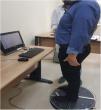To investigate the effects of bilateral subthalamic nucleus deep brain stimulation (STN-DBS) with different stimulation frequencies on static balance.
Materials and methodsTwenty patients (15 males and 5 females), aged between 43 and 81 (mean: 60.05±7.4) years, who had been diagnosed with idiopathic Parkinson's disease (PD) and undergone STN-DBS surgery were included in the study. Static balance was assessed with TecnoBody Rehabilitation System at four different frequencies: 230, 130, 90 and 60Hz and off-stimulation. Static balance tests were ‘stabilometric test, stabilometric compared bipedal closed/opened eye, stabilometric compared mono pedal (right/left foot)’. These tests reported the centre of pressure data ‘ellipse area, perimeter, front/back and mediolateral standard deviations’.
ResultsThere were no statically differences between the static balance test results at any frequency (p>0.05), but results were found better at 90Hz. Stabilometric compared bipedal opened eye forward–backward standard deviation result was significant between off-stimulation and 130Hz (p=0.04). Different frequency stimulation affected the static balance categories percentage with no statistical significance between off-stimulation and others (all p>0.05).
ConclusionThis study showed that STN-DBS did not affect the static balance negatively. Low-frequency (LF) stimulation improved the static equilibrium. Posturography systems will give more precise and quantitative results in similar studies with wide frequency ranges.
Investigar los efectos de la estimulación cerebral profunda del núcleo subtalámico bilateral (STN-DBS) con diferentes frecuencias de estimulación sobre el equilibrio estático.
Materiales y métodosSe incluyó en el estudio a 20 pacientes (15 varones y 5 mujeres), con edades comprendidas entre 43 y 81 años (media: 60,05±7,4), que habían sido diagnosticados de enfermedad de Parkinson idiopática e intervenidos mediante cirugía STN-DBS. El equilibrio estático se evaluó con el sistema de rehabilitación TecnoBody en 4 frecuencias diferentes: 230, 130, 90 y 60Hz y sin estimulación. Las pruebas de equilibrio estático fueron: prueba estabilométrica, ojo cerrado/abierto bípedo comparado con estabilométrico, monopedal comparado con estabilométrico (pie derecho/izquierdo). Estas pruebas informaron el centro de datos de presión: área de elipse, perímetro, desviaciones estándar mediolateral y frontal/posterior.
ResultadosNo hubo diferencias estadísticamente significativas entre los resultados de la prueba de equilibrio estático en cualquier frecuencia (p>0,05), pero los resultados fueron mejores con 90Hz. El resultado de la desviación estándar hacia adelante-atrás del ojo abierto bípedo comparado con el estabilométrico fue significativo entre la estimulación inactiva y 130Hz (p=0,04). La estimulación de diferente frecuencia afectó al porcentaje de categorías de equilibrio estático, sin significación estadística entre la estimulación inactiva y otras (todas p>0,05).
ConclusiónEste estudio mostró que STN-DBS no afectó negativamente al equilibrio estático. La estimulación de baja frecuencia mejoró el equilibrio estático. Los sistemas de posturografía darán resultados más precisos y cuantitativos en estudios similares con amplios rangos de frecuencia.
Article

If it is the first time you have accessed you can obtain your credentials by contacting Elsevier Spain in suscripciones@elsevier.com or by calling our Customer Service at902 88 87 40 if you are calling from Spain or at +34 932 418 800 (from 9 to 18h., GMT + 1) if you are calling outside of Spain.
If you already have your login data, please click here .
If you have forgotten your password you can you can recover it by clicking here and selecting the option ¿I have forgotten my password¿.











